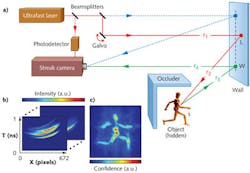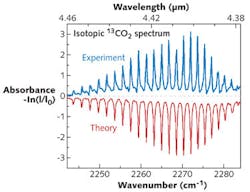TECHNOLOGY REVIEW 2012: Top 20 photonics innovations of 2012 light the way to future advances

In most cases, there is no objective "best" in the world of technology. Microsoft Windows, Apple OS X, and Linux (not to mention iOS and Android) all have their own fans, while in the world of photonics, an optical design engineer will likely get excited about something different than will a laser scientist. This 2012 Tech Review article takes the form of a "top 20" list of especially interesting items (across all of the categories we cover) that appeared this past year in Laser Focus World; these are one editor's picks, and we encourage you to take a look back through our last 12 issues to revisit your own favorites.
Looking around corners
Time-of-flight (ToF) camera. Ordinarily, no one can see around corners without using a mirror; however, scientists at the Massachusetts Institute of Technology (Cambridge, MA) can, with the aid of a streak camera and ultrafast laser pulses for illumination (see Fig. 1). The ToF setup and some heavy number-crunching produce 3D reconstructions of hidden objects (see "Time-of-flight camera sees around corners," Laser Focus World, June 2012; http://bit.ly/KRPzry).
Retinal prosthesis. Imaging technology, in the form of a video-camera implant, has found its way inside the human eye (see "PV retinal prosthesis has high pixel density," Laser Focus World, July 2012; http://bit.ly/MBDOIi). With the aid of an external wireless connection for computation, a photovoltaic array mounted on the retina directly stimulates retinal neurons to allow sight.
Single-photon detectors. Fast superconducting-nanowire single-photon detector technology is in heavy development; new geometries and applications are still being found. For example, meandering gold nanowires serve as optical nano-antennae to capture photons with a 47% efficiency for TM-polarized light (see "Optical nano-antennae boost speed and efficiency of single-photon detectors," Laser Focus World, January 2012; http://bit.ly/xXSXHn).
Green laser diodes. One of the most anticipated goals in laser technology is the creation of a robust green laser diode—with "green" meaning that it produces a wavelength in the 530 to 535 nm range optimal for use in red-green-blue laser projectors. Researchers at Sumitomo and the Advanced Materials Laboratory of Sony (Atsugi, Japan) unveiled laser diodes emitting more than 100 mW at 532 nm, with some devices emitting (at an unspecified power) at wavelengths as long as 536.6 nm (see "Green laser diode emits at 536 nm," Laser Focus World, August 2012; http://bit.ly/NcSbOR).
Blue laser diodes. The laser diode receives another gold star this year: Blue-emitting gallium-nitride-based laser diodes are now being used by researchers at KMLabs (Boulder, CO) to directly pump titanium-doped sapphire (Ti:sapphire) ultrafast lasers, which are traditionally pumped by more expensive and complex sources such as frequency-doubled neodymium-doped lasers (see "Pumping of Ti:sapphire moves to the blue," Laser Focus World, September 2012; http://bit.ly/P48thv).
Optical parametric oscillator. An optical parametric oscillator developed at Stanford University (Palo Alto, CA) has a spectral output so wide—from 2.6 to 6.1 µm, which is more than an octave—that no tuning is needed for broadband applications. The device could be ideal for frequency-comb spectroscopy (see "Broadband OPO spans the mid-IR, no tuning needed," Laser Focus World, July 2012; http://bit.ly/NoIPhK; see Fig. 2).Controlling light
Air-core fibers. Microstructured air-core optical fibers can act as flexible waveguides to efficiently channel terahertz radiation (see "Air-core microstructured fibers provide low-loss, broadband terahertz guidance," Laser Focus World, March 2012; http://bit.ly/wyQGww). Fabricated from PMMA polymer, the fibers have core diameters on the order of 2 mm.
Few-mode fibers. As for fiber-optic communications, taking advantage of the multiple modes in few-mode fibers to achieve spatial-division multiplexing (SDM) is a hot area right now. A group at the College of Optics & Photonics at the University of Central Florida (CREOL; Orlando, FL) has created a remarkable fiber amplifier that has controllable gain for the numerous SDM modes that travel down a few-mode fiber (see "Few-mode fiber amplifiers assist spatial-division multiplexing," Laser Focus World, May 2012; http://bit.ly/L93VVc).
Holographic data storage. Volumetric optical data storage has been a longtime focus of R&D; now, Access Optical Networks (Monmouth Junction, NJ) is seeking partners to commercialize its holographic data storage approach that relies on crystalline media to store data that is read in and out via spatial light modulators (SLMs; see "Holographic data storage uses volumetric crystal media," Laser Focus World, February 2012; http://bit.ly/A8jHy8).
Nanostructured lens production. While gradient-index (GRIN) lenses can be produced in many ways, a "stack and draw" approach pioneered at Heriot-Watt University (Edinburgh, Scotland) and the Institute of Electronic Materials Technology (Warsaw, Poland) relies on repeatedly drawing arrays of optical fibers with differing refractive indices down to subwavelength diameters to create a continuous GRIN profile (see "Stack-and-draw produces nanostructured lenses," Laser Focus World, August 2012; http://bit.ly/MRWR1O).
Photoacoustic scanner. Combining light with ultrasound is proving to be a powerful way to image tissue in living humans. Near-infrared (NIR) light pulses can produce rapid (but safe) heating within tissue, creating ultrasound pulses that allow 3D imaging in fine detail, with resolutions much smaller than a millimeter (see "In vivo photoacoustic scanner images tumor vasculature and therapy response," Laser Focus World, May 2012; http://bit.ly/IChmNG).
Nanoresonator light source. What quantum optics, encryption, computing, and the like particularly need is a light source that produces single photons in a predictable way (the conventional approach of drastically attenuating a laser beam has an unpredictable output). A group of German researchers has created just that—a light-pumped resonator that has an "antibunching" output (see "Nanoresonator heralds promise as new single-photon source," Laser Focus World, June 2012; http://bit.ly/LlXSNx).
Sensing redefined
Speckle interferometer. A nonimaging speckle interferometer created by Dutch scientists uses a single photodiode to detect position of a scatterer to subnanometer precision, relying on SLMs to create wavefront "fingerprints" related to scatterer position (see "Speckle interferometer detects position at high speed," Laser Focus World, April 2012; http://bit.ly/H05vC4).
Wind-turbine lidar. Wind-turbine lidar systems being developed at many locations around the world are helping engineers to improve wind energy efficiency; these systems can be either continuous-wave or pulsed, with the systems mounted to the nose or the nacelle of the wind turbine (see Fig. 3; also see "Wind energy gets a boost from wind-turbine lidar," Laser Focus World, May 2012; http://bit.ly/JfTKfz).Terahertz systems. Terahertz spectroscopy gives access to vibrational, rotational, and translational molecular spectral lines that can, for example, tell the difference between single- and double-stranded DNA; this is accomplished by a terahertz scanning reflectometer combined with a broadband electro-optic dendrimer emitter (see "Terahertz technology enables systems for molecular characterization," Laser Focus World, January 2012; http://bit.ly/zaCK7n).
Resonant spectroscopy. A mass-producible chip-based resonant spectrometer less than 0.5 mm2 in size developed at ZiNIR (Eastbourne, England) enables low-cost distributed spectrometer networks on the ground, in space, or even in living tissue (see "Chip-based resonant spectroscopy overcomes traditional challenges," Laser Focus World, October 2012; http://bit.ly/SXfALH).
The photonics toolbox
Laser system modeling software. Designing active photonic systems such as lasers and amplifiers has just become much easier, thanks to software unveiled by Simphotek (Newark, NJ). The suite has a graphic interface that includes icon-like blocks that, while easy to manipulate, represent the very abstruse physics required to model laser systems in fine detail (see "Simulating active photonic materials becomes easy," Laser Focus World, September 2012; http://bit.ly/RnwQtg).
Ray-tracing tool. Stray light in the form of haloes, one of the curses of optical-system design, is being tackled by engineers at DigitalOptics Corp. (San Jose, CA), who have created software that models ghost images, haloes, and other reflections that standard models don't predict due to lack of input of certain material parameters. Applied to wafer-level camera system design, the software dramatically reduced stray light effects (see "Ray-tracing model pinpoints cause of stray-light halos," Laser Focus World, January 2012; http://bit.ly/weOaEk).
Motion control for ultrahigh vacuum. The ultrahigh-vacuum environments required for sensitive instruments such as laser-based gravitational-wave detectors and quantum-optical setups present challenges for motion-control devices, which tend to be a source of outgassing. Improved design can lead to actuators that can survive a high-temperature bake-out process, have fewer cavities that entrap air, and are free of volatiles (see "UHV environments require more from motion systems," Laser Focus World, May 2012; http://bit.ly/J0YbxD).
Piezo actuator. Breaking away from conventional form, scientists at Georgia Tech (Atlanta, GA) are designing piezo actuators that imitate biological motions, allowing a robotic camera to point this way and that like a human eye. The researchers combine amplified piezo stacks to achieve the motion needed (see "Biologically inspired piezo actuator lets robotic camera mimic human eye movement," Laser Focus World online, August 2012; http://bit.ly/N1uTi9).
Our thanks go out to all the other photonics innovators of 2012 who appeared in Laser Focus World, and whose ideas, devices, systems, and software are already laying the groundwork for the next generation of achievements in photonics. Please visit our web site, www.laserfocusworld.com, where you will find this past year's accomplishments in photonics in easily searchable form.

John Wallace | Senior Technical Editor (1998-2022)
John Wallace was with Laser Focus World for nearly 25 years, retiring in late June 2022. He obtained a bachelor's degree in mechanical engineering and physics at Rutgers University and a master's in optical engineering at the University of Rochester. Before becoming an editor, John worked as an engineer at RCA, Exxon, Eastman Kodak, and GCA Corporation.

